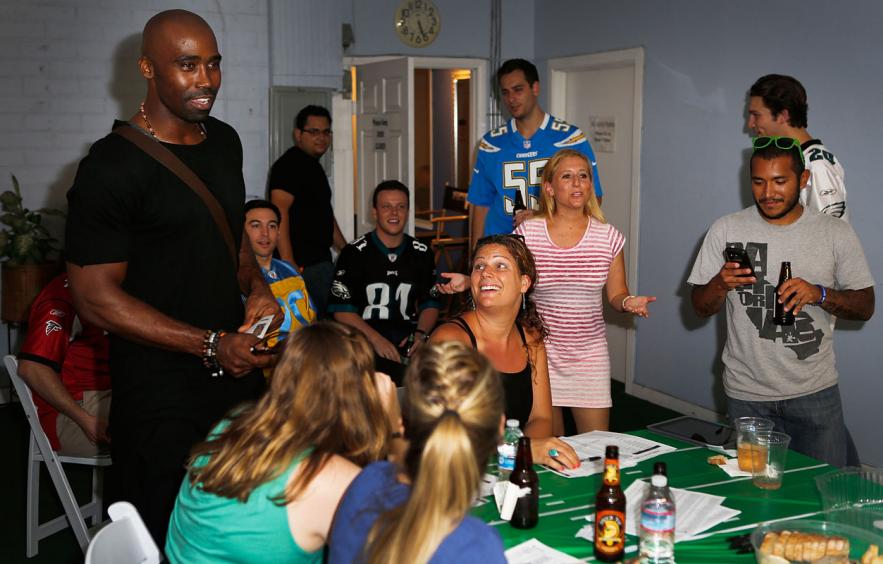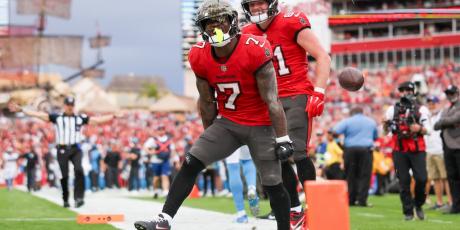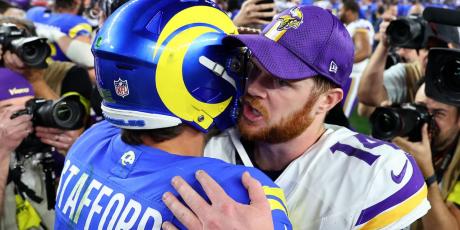Striking at Value in Salary Cap Drafts

It was coming into the 2018 draft that I had my first Moneyball moment when looking at the salary cap landscape, it seemed clear to me that my league was undervaluing elite running backs. Top-tier running backs are usually the most valuable assets in fantasy football, which is why in snake drafts they often make up the bulk of first and second-round picks. Each player in a salary cap draft goes to the highest bidder, and my league was still gunshy about paying over $70 of a $200 budget for a single asset, even though the top running backs are almost always worth more.
More Salary Cap Content: Studs & Scrubs Approach | How to Approach Salary Cap Drafts | 12-Team Salary Cap Mock | The Rule of One: How to Avoid Derailing Your Salary Cap Drafts
In line with the Studs and Scrubs philosophy, I decided to take advantage of this gap by gunning for both Todd Gurley and David Johnson. If I got them at what would be a discount compared to their true value, I could fill the rest of my roster with cheaper assets and still contend. Gurley was the clear top pick on draft boards heading into the season, followed by a toss-up between Johnson and Ezekiel Elliott, and I preferred DJ for his larger role as a pass-catcher.
Draft night came and the first player on the board was Gurley, who I secured for just $69. Elliott was the next player nominated, and the bidding on him slowed down in the high-$50 range. I soon heard “going once” at a price of just $61, and with the flip of a switch changed my plan to strike at Zeke; while I preferred Johnson, I knew that they had near equal rankings and that Johnson would almost certainly command a higher price, and he ended up going for $70 as drafters scrambled for an elite back.
I left that draft the proud owner of Gurley, Eliott, and a promising quarterback prospect named Patrick Mahomes, and rode their backs to a championship. Gurley was an absolute force that season, averaging a career-high 24 points per game in half-point PPR. Zeke had an outstanding year as well, finishing as the No. 5 running back, but more remarkable is that he outscored Johnson (No. 10 running back) by over five points per game. Both were strong assets, but the preseason toss-up between the two looked a bit foolish in hindsight.
This story shows that we can be flawed in trying to predict who will have a better season between two similar players. Every year, people will confidently proclaim that a certain player is either a guaranteed breakout or bust, but we aren’t great at forecasting that in reality. This is good news for a flexible drafter; if you can orient yourself toward a desired roster construction rather than specific players, you can find value across all positions come draft night. If you look for discounts and avoid emotional bidding wars, you may have the most valuable roster entering the season.
The Efficient Market Hypothesis
One of the first principles I learned while studying finance is called the efficient market hypothesis, which states that the price of an asset will reflect all publicly available information about it. Put simply, it’s impossible to consistently pick winners (breakouts) and losers (busts) among stocks in the long term because you don’t know anything that the rest of the world doesn’t.
This principle applies to fantasy football as well; there are so many resources surrounding us that ADP rankings and draft boards begin to look very similar. You’ll see some players shuffled around their peers, such as John Paulsen’s rankings being higher on Tony Pollard than other sites. However, natural groupings will still form, and you won’t see many people arguing for Tony Pollard over Austin Ekeler or CeeDee Lamb over Ja'Marr Chase.
In a salary cap draft, these groupings (tiers) are your friend. There will be players in each tier that fly under the radar and get drafted for less than their peers, usually for irrational reasons. Rather than split hairs over whether Chris Olave or DeVonta Smith is in for a better season, a flexible drafter can set out to target whichever one goes at a better price. By the end of the draft, you can have a roster that perfectly fits your desired construction with players that you got at a discount.
Striking at Value
This approach takes patience and planning, but the rewards are worthwhile. The four steps to landing consistent deals in your draft are:
1. Build your budget
Are you committed to spending $1 on your QB and TE so you can get Studs at RB and WR? Do you prefer a Zero-RB approach? Have you noticed pockets where your league historically overvalues or undervalues a position? Let your ideal roster preferences guide your draft choices. Give yourself a clear path by assigning a budgeted dollar value to each roster spot, knowing that you’ll need to be slightly flexible.
2. Understand player values
Our 4for4 Auction Cheat Sheets will help you get to know how much each player can be expected to be drafted for. BeerSheets is another popular resource that tailors to your league settings. Everybody has their favorite rankings to feel confident about player value going into the draft, the key is to have an idea of what price any given player should be going for.
3. Tier your draft board
Do you have a clear preference between Justin Herbert and Trevor Lawrence, or are you comfortable taking whoever is cheaper? Where do you think talent drops off at the wide receiver position? Understanding the cutoff points lets you group the players you want to highlight and grab whichever one presents a discount. Some rankings will provide these tiers for your reference, but it’s also valuable to make your own decisions here.
4. Draft flexibly
You should enter the draft well-researched and confident, but that doesn’t make the draft easy. When you take this approach every player nominated can end up on your team, as long as they’re going for the right price. Use your budget as a guide, but don’t be afraid to adjust accordingly as the draft goes on, let your values help you determine if people are spending too much or too little, and use your tiers to target the players going for less than their peers.
Bottom Line
- The fantasy community is pretty good at broad rankings, but not great at predicting which of two similarly ranked players will have the stronger season.
- Looking at players through positional tiers rather than individual rankings can be much more effective in roster building and planning for salary cap drafts.
- If you remain agile and strike at players being drafted cheaper than their ADP peers, you can dominate your draft and enter the season with a roster of valuable but discounted assets.























